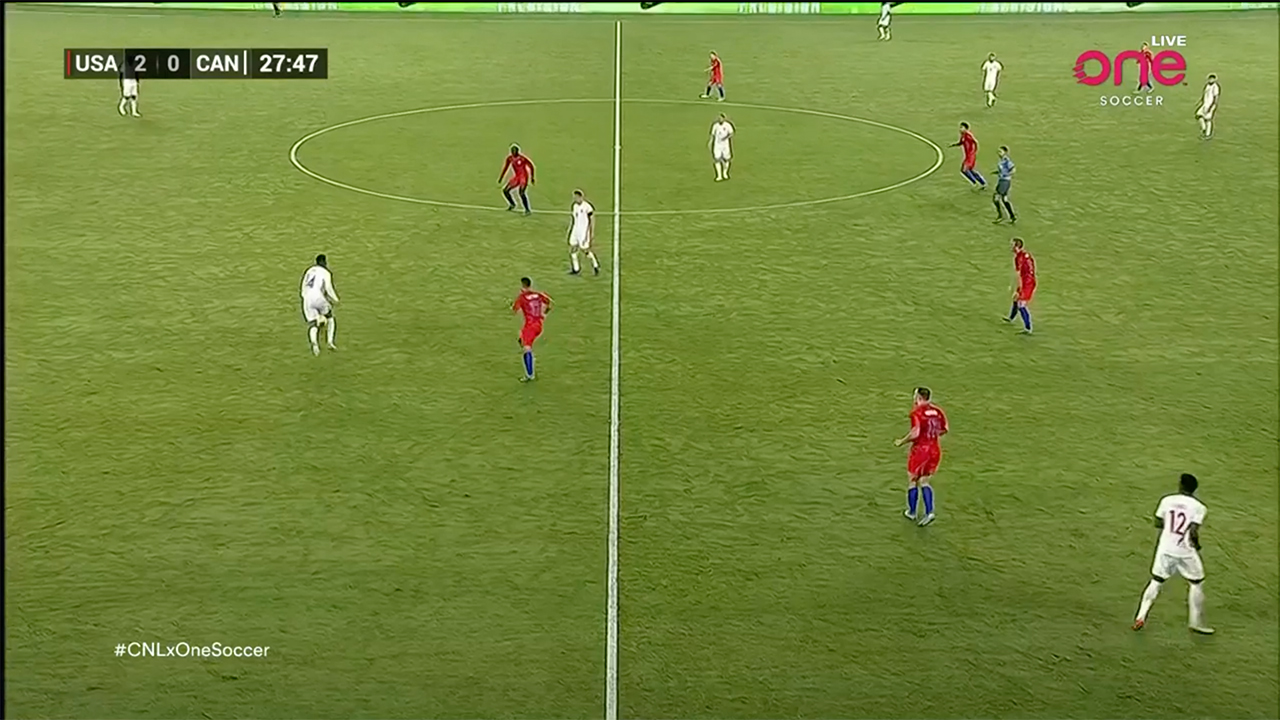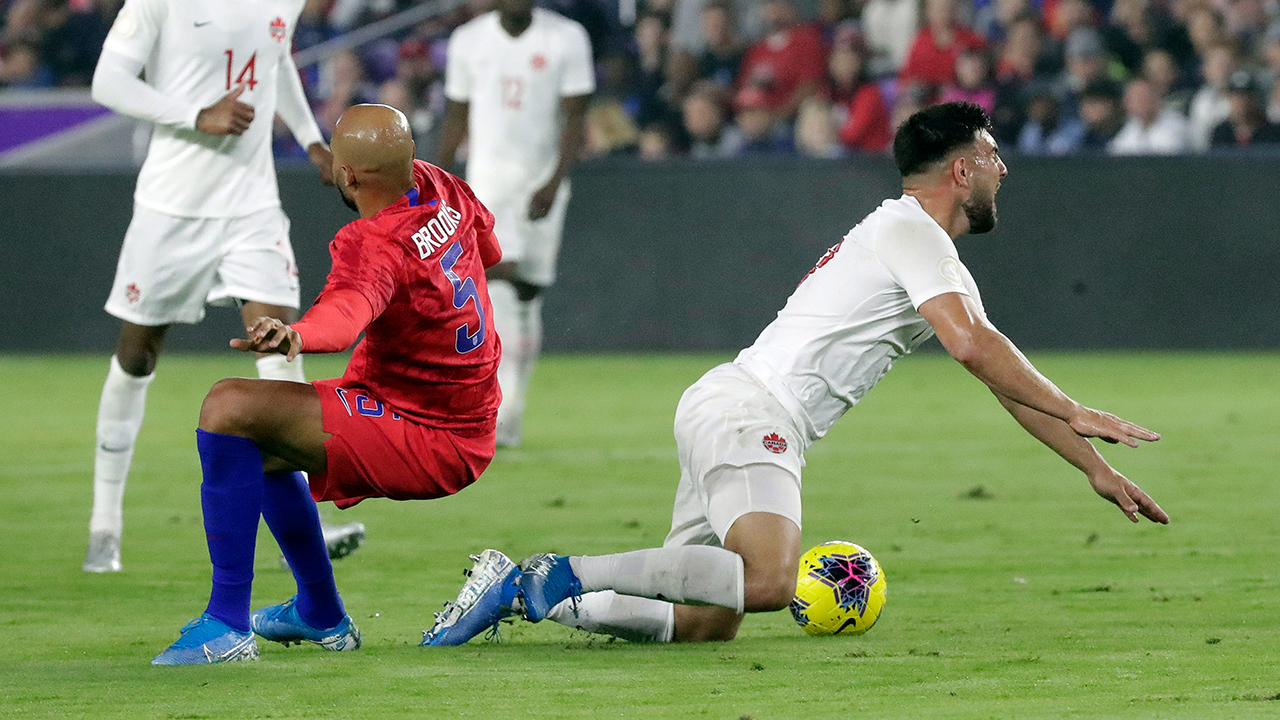Canada’s hopes of progressing to the Concacaf Nations League semifinals, and qualifying for the hexagonal phase of World Cup qualifying, are now under threat.
After a monumental victory over the U.S. last month at BMO Field, the Canadians lost 4-1 to the Americans in Orlando on Friday to close out their Nations League group stage campaign.
Canada can still qualify for the “Hex” and the Nations League semifinals, but they will need other results to go their way for the rest of the weekend.
Notable games remaining:
(Friday)
(Sunday)
(Sunday)
(Tuesday)#CanMNT— Peter Galindo (@GalindoPW) November 15, 2019
Here are three takeaways from the match.
If it ain’t broke, don’t fix it
Coach John Herdman only made two changes to the team that defeated the U.S. last month, but those changes ultimately cost Canada on Friday night.
Defenders Derek Cornelius and Kamal Miller were replaced by Doneil Henry and Lucas Cavallini, respectively. However, Alphonso Davies — who started five straight games for Bayern Munich as a full-back before the international break — was moved to left-back.
That ultimately led to a litany of defensive breakdowns that the U.S. capitalized on throughout the first half.
First, it was Davies’ giveaway that led to the corner before the opening goal. Then he left Jordan Morris unmarked right after Paul Arriola took the set piece. A failure to monitor Jackson Yueill at the top of the box allowed the midfielder to shoot unchallenged.
Then, the U.S. pounced in transition, catching Canada’s full-backs high up the pitch. Steven Vitoria misjudged the cross to Jordan Morris, goalkeeper Milan Borjan stormed out to stop Morris, but the deflection off Borjan carried the ball into Gyasi Zardes’ path.
Eventually, the Americans made it 3-0 off another set piece as Canada was caught napping again.
Davies’ night further enhances the fact that he should not be deployed as a defender for Canada. It’s easier to do so for Bayern Munich in a more structured tactical environment with a strong supporting cast.
Until Davies gains more comfort at the position, he should not be playing left-back, especially with a match-fit option in Sam Adekugbe available.
Adekugbe started in Canada’s 1-0 victory over Cuba and combined well with Davies in that match. It would’ve allowed Davies to constantly exploit Sergino Dest at right-back, who struggles one-against-one, as stated before the match.

As for Henry’s inclusion over Cornelius, it’s bizarre to split up centre-backs who earned a clean sheet against this same U.S. side in the previous match. Chemistry is vital for central defenders and the Henry-Vitoria partnership had not started a competitive game together prior to Friday’s game.
By changing two defenders, the structure was disjointed the entire night. Canada was constantly behind the eight-ball because of it. These lessons should’ve been learned from the Haiti loss.
A complete 180 from U.S.
While Canada was poor defensively, credit has to be given to the U.S. for a significantly improved performance.
The U.S. was outworked and completely out of sorts in October. They had to make a few adjustments from that match to swing the momentum, and that’s what transpired.
For starters, the U.S. pressed and harried the Canadian defence. It forced Borjan, who is not comfortable on the ball, to hit it long and it created the second goal.
The U.S. was also compact off the ball and it stifled Canada’s passing lanes.

In a role reversal from last month, the U.S. was everything Canada wasn’t on Friday. The hosts were disciplined, organized, tenacious and clinical in front of goal, as evidenced by the expected goals (xG).
#USMNT had 37% possession vs Canada, its lowest in a win since 2016 Copa América vs Paraguay.
Expected goals tonight…
U.S.: 1.97 xG on 12 shots
Canada: 0.99 xG on 11 shots— Paul Carr (@PaulCarr) November 16, 2019
Examining Canada’s hopes of reaching the “Hex”
To put it simply, Canada will need a lot to go its way to reach the hexagonal phase of World Cup qualifying next year.
Since FIFA rankings determine the top six in Concacaf, a result in Orlando would’ve boosted Canada’s hopes.
With El Salvador right behind Canada in seventh place in the Concacaf rankings, the Reds risk falling out of the top six after this international window.
Canada will gain 16.89 pts with a win tonight, 4.39 with a draw and lose 8.1 with a loss.
El Salvador will gain 10.1 points if it wins both its League B games. Curacao is done for the window and Panama would gain 10.05 if it beats Mexico (6.55 draw -5,95 loss)
— Duane Rollins (@24thminute) November 15, 2019
Best case for Canada would be if El Salvador somehow screwed up again. Realistic best case is
6th – Canada 1356
7th – El Salvador 1346Worst case is:
6th – El Salvador 1346
7th – Panama 1339
8th – Canada 1331Mediocre possibility:
6th – El Salvador 1346
7th – Canada 1343— Duane Rollins (@24thminute) November 15, 2019
If Canada finishes outside the top six, then it has to compete in a knockout-style repechage, which is a far more complex and difficult route to reaching the World Cup.
As for the possibility of reaching the Nations League semifinals, Canada can still qualify if the U.S. fails to beat Cuba on Tuesday, but that is unlikely.
[relatedlinks]

